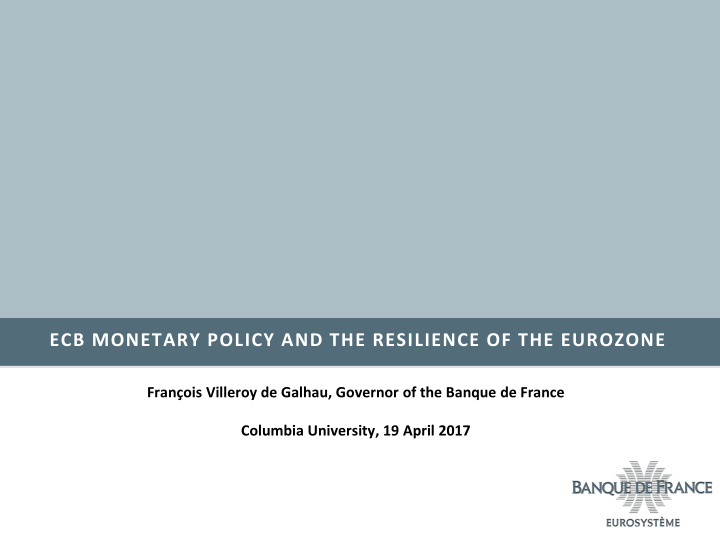



ECB MONETARY POLICY AND THE RESILIENCE OF THE EUROZONE François Villeroy de Galhau, Governor of the Banque de France Columbia University, 19 April 2017
Citizens’ support for the euro Strong support for the euro 100 90 81% 80 70% 68% 70 60 Euro area 50 France 40 Germany 30 20 10 0 S2 2016 Source: European Commission, Standard Eurobarometer 86, Autumn 2016. 2
Benefits of the euro: better controlled inflation Inflation % 14 1 January 1999 12 10 8 6 4.6% 4 1.7% 2 0 1980 1984 1988 1992 1996 2000 2004 2008 2012 2016 pre-euro average post-euro average euro area inflation Source: ECB AWM database, INSEE 3
Benefits of the euro: lower interest rates 10 Y interest rate spread France-Germany and Italy-Germany 12 Spread France-Germany 1992: Maastricht Spread Italy-Germany Treaty Average France 10 Average Italy 8 6 5.1% 4.0% 4 -3.7% 1.9% 2 1.4% -1.5% 0.4% 0 1980 1982 1984 1986 1988 1990 1992 1994 1996 1998 2000 2002 2004 2006 2008 2010 2012 2014 2016 Source: Eurostat. -2 4
Monetary policy: successful crisis management 5
Monetary policy: financial conditions have eased Interest rates on bank loans to non-financial corporations Credit growth % % % % 8 8 4 4 6 6 3,5 3,5 4 4 EA: -100 bp 2 2 3 3 0 0 -2 -2 2,5 2,5 -4 -4 Spread IT-FR: -6 -6 -60 bp 2 2 -8 -8 janv.-14 janv.-15 janv.-16 janv.-17 2011 2012 2013 2014 2015 2016 Germany France Italy Euro area France Italy Germany Euro area Source: ECB 6
Growing convergence of growth rates GDP growth rate (%) 3 2,6 2,5 2,2 2,1 2 1,8 1,8 1,8 1,7 1,6 1,6* United States 1,5 United Kingdom Euro area 1 0,5 0 2015 2016 2017 *not taking into account exceptional accounting effects for Ireland (+0.3%). Domestic sources: National sources for the US and the UK (Bureau of Economic Analysis and Office for National Statistics); Eurostat and March 2017 ECB staff projections for the euro area. 7
Requirements for action in Europe: domestic reforms give results • Several euro area countries have succeeded in carrying out in-depth reforms: Germany, Netherlands , Spain,… while preserving the European social model. Aggregate growth in market sector employment Aggregate GDP growth 2014-2016 (%) 2014-2016 (%) 10 7 6 8 5 6 4 3 4 2 2 1 0 0 Source: Eurostat. 8
Requirements for action in Europe: the “growth triangle” of Economic Union Financing Union for Investment and Innovation Microeconomic Convergence / dynamics macroeconomic (competitiveness) stabilisation National structural Euro area reforms policy-mix Collective economic strategy 9
Recommend
More recommend